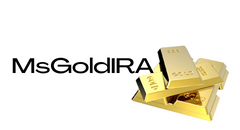The Impact of Inflation on the Economy
Last week, the focus of traders was on the Consumer Price Index (CPI) report, which was released yesterday. The report revealed that inflation had exceeded expectations, marking its biggest monthly increase in August this year. Inflation is now up 3.7% compared to a year ago. Surprisingly, the market didn't react strongly to this news. Stock market futures initially fell but quickly recovered, resulting in a volatile trading day.
Effects on Assets and Treasury Yields
Unsurprisingly, Treasury yields rose following the inflation report. As we discussed in our previous post, this performance has negative implications for gold and silver. In the short term, a strong US dollar and high Treasury yields make these assets less attractive. This raises the opportunity cost of holding these liquid assets.
However, it's important to note that inflation still persists, as we explained last week. The reason why the US dollar and yields are high is because of inflation. It's ironic, considering the negative impact of inflation on a currency, the economy, and its citizens. But in the grand scheme of things, this is a short-term phenomenon.
Transportation and Inflation
Headlines have focused on transportation as one of the sectors hit hardest by inflation. This is primarily attributed to rising oil prices. While the pace of oil price increases has slowed, the full impact of higher prices is yet to be felt in the economy. When households start experiencing sustained increases in gas prices every week, it will undoubtedly affect their inflation expectations. Additionally, we must consider how increased production costs will eventually contribute to core inflation.
Furthermore, despite economists celebrating the deflationary trends in goods and rents, the harsh reality is that other key sectors are still experiencing price hikes. Examples include healthcare and household furnishings (credit to Omar Sharif, Inflation Insights). The spread of inflation is becoming broader, which can make it feel less impactful in the short term.
The Elephant in the Room
To illustrate the situation, consider an elephant wearing shoes (bear with me). When energy prices skyrocketed due to geopolitical tensions, it was like an elephant wearing stilettos stepping on the global economy. This created a concentrated pain source. However, as the effects of poor monetary policy, financial crises, and pandemics materialize, it's now as if the elephant is wearing trainers and standing on the economy. The weight remains the same, but it's spread across a larger surface area. As a result, the pain feels less severe.
But what happens when the elephant gets comfortable? There's only so long one can tolerate an elephant standing on them, regardless of the type of shoes it's wearing.
FOMC's September Meeting and the ECB Meeting
Next week, the Federal Open Market Committee (FOMC) is scheduled to meet. No significant drama is expected. Throughout the summer, Fed members have expressed their commitment to fighting inflation by keeping rates higher for a longer period.
Meanwhile, today marks the European Central Bank (ECB) meeting, which is particularly interesting. The Eurozone is projected to continue exceeding its 3% inflation target well into next year. ECB members must have debated whether they should raise rates to tackle this issue. However, considering the signs of a looming recession, is hiking rates a wise decision? The committee found itself facing a difficult choice, and neither outcome is appealing at the moment.
Ultimately, the ECB decided to raise rates to an all-time high of 25 basis points, or 4%. Unsurprisingly, the euro weakened against the dollar. This decision is undoubtedly the ECB's most significant in over a year, indicating their greater concern with keeping inflation below the target rather than preventing a recession.
The Dilemma and Moving Forward
So, where does this leave us? In a familiar position. Central bankers continue to grapple with inflation, striving to bring it down to an arbitrary level. It's an exercise in futility.
With their meetings, press conferences, and endless models, central bankers seem convinced that there is a one-size-fits-all solution. They believe they can use models and predictions to navigate this crisis. However, history reminds us that life and economics are unpredictable and complex. There is no perfect solution. Some groups try to make decisions based on skewed models and data that may not accurately reflect the current situation or the future.
Given these circumstances, we must stay steadfast. We should consider adding gold to our portfolios and appreciate its strong performance this year, despite the strength of the US dollar and Treasury yields. Let's remain firm and disregard the noise from central bankers and data releases.
Gold Price Updates
| Date | AM LBMA Fix – USD | PM LBMA Fix – USD | AM LBMA Fix – GBP | PM LBMA Fix – GBP | AM LBMA Fix – EUR | PM LBMA Fix – EUR |
|---|---|---|---|---|---|---|
| 13-09-2023 | 1912.15 | 1913.80 | 1533.16 | 1532.00 | 1781.55 | 1782.51 |
| 12-09-2023 | 1918.90 | 1908.55 | 1538.96 | 1530.28 | 1790.14 | 1780.68 |
| 11-09-2023 | 1926.60 | 1924.95 | 1538.39 | 1536.30 | 1796.36 | 1792.71 |
| 08-09-2023 | 1925.55 | 1927.80 | 1543.14 | 1542.43 | 1799.43 | 1796.90 |
| 07-09-2023 | 1919.85 | 1918.35 | 1538.38 | 1540.05 | 1791.60 | 1794.04 |
| 06-09-2023 | 1923.45 | 1922.05 | 1532.03 | 1537.26 | 1793.23 | 1793.46 |
| 05-09-2023 | 1931.80 | 1926.10 | 1539.84 | 1533.75 | 1797.15 | 1796.09 |
| 04-09-2023 | 1942.05 | 1937.20 | 1537.72 | 1534.46 | 1798.34 | 1795.01 |
| 01-09-2023 | 1944.30 | 1940.55 | 1532.89 | 1532.84 | 1791.28 | 1790.74 |
| 31-08-2023 | 1944.20 | 1942.30 | 1533.58 | 1532.47 | 1788.28 | 1789.83 |
| 30-08-2023 | 1938.35 | 1947.55 | 1530.33 | 1528.63 | 1780.57 | 1779.87 |
If you're interested in investing in gold, consider buying gold coins and bars and storing them in secure vaults in Switzerland, London, or Singapore with GoldCore. Switzerland remains a safe-haven jurisdiction for precious metals ownership. Access our popular guide, the Essential Guide to Storing Gold in Switzerland, to learn more.
Sign up to receive our award-winning market updates in your inbox. Stay informed and make informed investment decisions.
Remember, amidst the ongoing struggle with inflation, gold continues to shine. Remain focused, ignore the noise, and trust in the potential of this valuable asset.
This article was originally published on GoldCore News.
Frequently Asked Questions
What is the value of a gold IRA
The benefits of a gold IRA are many. You can diversify your portfolio with this investment vehicle. You control how much money goes into each account and when it's withdrawn.
Another option is to rollover funds from another retirement account into a IRA with gold. This makes for an easy transition if you decide to retire early.
The best part is that you don't need special skills to invest in gold IRAs. They're available at most banks and brokerage firms. Withdrawals are made automatically without having to worry about fees or penalties.
There are also drawbacks. Gold is known for being volatile in the past. So it's essential to understand why you're investing in gold. Are you looking for growth or safety? Is it for security or long-term planning? Only once you know, that will you be able to make an informed decision.
If you are planning to keep your Gold IRA indefinitely you will want to purchase more than one ounce. You won't need to buy more than one ounce of gold to cover all your needs. Depending upon what you plan to do, you could need several ounces.
You don't have to buy a lot of gold if your goal is to sell it. You can even live with just one ounce. These funds won't allow you to purchase anything else.
Should You Buy or Sell Gold?
Gold was a safe investment option for those who were in financial turmoil. Many people are now turning their backs on traditional investments like stocks and bonds, and instead look to precious metals like Gold.
Although gold prices have shown an upward trend in recent years, they are still relatively low when compared to other commodities like oil and silver.
Some experts believe that this could change very soon. They say that gold prices could rise dramatically with another global financial crisis.
They also point out that gold is becoming popular because of its perceived value and potential return.
Here are some things to consider if you're considering investing in gold.
- Consider whether you will actually need the money that you are saving for retirement. It is possible to save enough money to retire without investing in gold. However, when you retire at age 65, gold can provide additional protection.
- Second, make sure you understand what you're getting yourself into before you start buying gold.There are several different types of gold IRA accounts available. Each offers varying levels of flexibility and security.
- Last but not least, gold doesn't provide the same level security as a savings account. It is possible to lose your gold coins.
If you are thinking of buying gold, do your research. Make sure to protect any gold you already own.
How Much of Your IRA Should Include Precious Metals?
You should remember that precious metals are not only for the wealthy. It doesn't matter how rich you are to invest in precious metals. There are many ways that you can make money with gold and silver investments, even if you don't have much money.
You could also consider buying physical coins like bullion bars, rounds or bullion bars. It is possible to also purchase shares in companies that make precious metals. Your retirement plan provider may offer an IRA rollingover program.
You can still get benefits from precious metals regardless of what choice you make. Although they aren’t stocks, they offer the possibility for long-term gains.
They also tend to appreciate over time, unlike traditional investments. So, if you decide to sell your investment down the road, you'll likely see more profit than you would with traditional investments.
How much gold should your portfolio contain?
The amount of capital required will affect the amount you make. If you want to start small, then $5k-$10k would be great. As you grow, it is possible to rent desks or office space. You don't need to worry about paying rent every month. You just pay per month.
You also need to consider what type of business you will run. In my case, we charge clients between $1000-2000/month, depending on what they order. You should also consider the expected income from each client when you do this type of thing.
As freelance work requires you to be paid freelancers, your monthly salary won't be as high as mine. Therefore, you might only get paid one time every six months.
You need to determine what kind or income you want before you decide how much of it you will need.
I recommend starting with $1k to $2k of gold, and then growing from there.
Can I buy gold with my self-directed IRA?
While you can purchase gold from your self-directed IRA (or any other brokerage firm), you must first open a brokerage account such as TD Ameritrade. Transfer funds from an existing retirement account are also possible.
Individuals can contribute as much as $5,500 per year ($6,500 if married filing jointly) to a traditional IRA. Individuals can contribute up to $1,000 annually ($2,000 if married and filing jointly) directly to a Roth IRA.
If you do decide you want to invest your money in gold, you should look into purchasing physical bullion instead of futures contracts. Futures contracts, which are financial instruments based upon the price of gold, are financial instruments. They let you speculate on future price without having to own the metal. However, physical bullion is real gold or silver bars you can hold in your hands.
How much should I contribute to my Roth IRA account?
Roth IRAs let you save tax on retirement by allowing you to deposit your own money. You can't withdraw money from these accounts before you reach the age of 59 1/2. However, if you do decide to take out some of your contributions before then, there are specific rules you must follow. You cannot touch your principal (the amount you originally deposited). This means that no matter how much you contribute, you can never take out more than what was initially contributed to this account. If you decide to withdraw more money than what you contributed initially, you will need to pay taxes.
The second rule says that you cannot withdraw your earnings without paying income tax. You will pay income taxes when you withdraw your earnings. Let's assume that you contribute $5,000 each year to your Roth IRA. Let's say you earn $10,000 each year after contributing. This would mean that you would have to pay $3,500 in federal income tax. The remaining $6,500 is yours. This is the maximum amount you can withdraw because you are limited to what you initially contributed.
Therefore, even if you take $4,000 out of your earnings you still owe taxes on $1,500. In addition, 50% of your earnings will be subject to tax again (half of 40%). So even though you received $7,000 in Roth IRA contributions, you only received $4,000.
There are two types of Roth IRAs: Traditional and Roth. Traditional IRAs allow for pre-tax deductions from your taxable earnings. Your traditional IRA allows you to withdraw your entire contribution plus any interest. There are no restrictions on the amount you can withdraw from a Traditional IRA.
A Roth IRA doesn't allow you to deduct your contributions. Once you are retired, however, you may withdraw all of your contributions plus accrued interest. There is no minimum withdrawal requirement, unlike traditional IRAs. Your contribution can be withdrawn at any age, not just when you reach 70 1/2.
Statistics
- You can only purchase gold bars at least 99.5% purity. (forbes.com)
- If you take distributions before hitting 59.5, you'll owe a 10% penalty on the amount withdrawn. (lendedu.com)
- (Basically, if your GDP grows by 2%, you need miners to dig 2% more gold out of the ground every year to keep prices steady.) (smartasset.com)
- If you accidentally make an improper transaction, the IRS will disallow it and count it as a withdrawal, so you would owe income tax on the item's value and, if you are younger than 59 ½, an additional 10% early withdrawal penalty. (forbes.com)
- Contribution limits$6,000 (49 and under) $7,000 (50 and up)$6,000 (49 and under) $7,000 (50 and up)$58,000 or 25% of your annual compensation (whichever is smaller) (lendedu.com)













